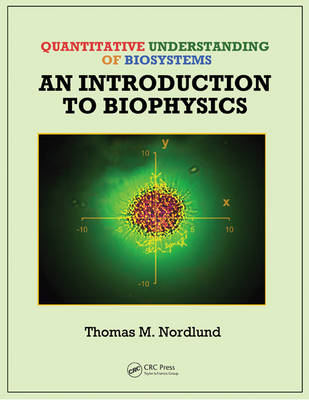
Quantitative Understanding of Biosystems
Crc Press Inc (Verlag)
978-1-4200-8972-1 (ISBN)
- Titel erscheint in neuer Auflage
- Artikel merken
Providing broad coverage of physics, chemistry, biology, and mathematics, this color text features:
Mathematical and computational tools—graphing, calculus, simple differential equations, diagrammatic analysis, and visualization tools
Randomness, variation, statistical mechanics, distributions, and spectra
The biological micro- and nanoworld—structures, processes, and the physical laws
Quantum effects—photosynthesis, UV damage, electron and energy transfer, and spectroscopic characterization of biological structures
Through its active learning approach, the text encourages practical comprehension of the behavior of biosystems, rather than knowledge of the latest research. The author includes graph- and diagram-centered physics and mathematics, simple software, frequent checks of understanding, and a repetition of important ideas at higher levels or from different points of view. After completing this book, students will gain significant computational and project experience and become competent at quantitatively characterizing biosystems.
CD-ROM Resource
The accompanying CD contains multimedia learning tools, such as video clips and animations, that illustrate intrinsically dynamic processes. For students inexperienced in the application of mathematics and physical principles to naturally occurring phenomena, this multimedia component emphasizes what is most obvious about biological systems: living things move. Students can also manipulate and re-program the included Excel graphs.
Thomas M. Nordlund is an associate professor in the Department of Physics at the University of Alabama at Birmingham. A Fellow of the American Physical Society, Dr. Nordlund has performed research in biomolecular dynamics for 30 years. He earned his Ph.D. in physics from the University of Illinois at Urbana-Champaign, under the supervision of Hans Frauenfelder.
INTRODUCTION, APPROACH, AND TOOLS
Introduction to a New World
Biological and Nonliving Worlds Contrasted
Hierarchical Structure and Function
Some Important Quantities to Get Started
Biophysics and Biochemistry Operate in Water (Water 1)
Important or "Hot" Issues in Biophysics, or How to Be Out-of-Date Quickly
Is There a Career Here Somewhere?
Read Appendix A
How (Most) Physicists Approach Biophysics
Dealing with Nonspherical Cows: Drive for Simplicity
Two Approaches to Biosystems
Comparison of "Physics" and "Biology" Approaches to Organisms
Memorization: Its Advantages and Dangers
Math Tools: First Pass
What Math Do We Need?
Notation: Mathematics vs. Physics Notations
Approximations
Vectors
Two- and Three-Dimensional Geometry
Calculus
Differential Equations
Distributions
STRUCTURE AND FUNCTION
Water
Introduction
Structure
Unusual Physical Properties
Summary of Important Physical Properties
Bulk vs. Local Structures
Diffusion and Chemical Reactions in Water
Solutes and the Solvent Power of Water
Points to Remember
Structures: From 0.1 to 10 nm and Larger
Software to Display and Analyze Biological Structures
Solvents
Small Molecules
Medium-Sized Molecules: Components of Large Biomolecules
Forces and Free Energies
Biopolymers
Macromolecules: When Does a Molecule Become a Macroscopic Object?
Points to Remember
First Pass at Supramolecular Structures: Assemblies of Biomolecules
Measuring Properties of Three-Dimensional Aggregates
Small Aggregates
Large Aggregates
Two-Dimensional Aggregates: Membranes
Points to Remember
Putting a Cell Together: Physical Sketch
Minimal, Prokaryotic, and Eukaryotic Cells
Physiology: Selective Overview
Reproduction, DNA, and the Cell Nucleus
Sensors and Recognition: Responding to the Outside World without Eyes
BIOLOGICAL ACTIVITY: QUANTUM MICROWORLD
Quantum Primer
Quantum Glossary
Schrödinger Equation and Other Tools of Quantum Mechanics
Pauli Exclusion Principle
From Atoms to Molecules
Collisions of Atoms and Molecules
Classical vs. Quantum: Is a 1-mm-Long Molecule of DNA a Quantum Object?
Points to Remember
Light and Life
Light: Our Energy Source
Crucial Differences between One 5-eV and Two 2.5-eV Photons
Properties of Photons
Scattering and Refraction
Absorption Spectra
Emission Spectra
Einstein Relations between Absorption and Emission of Atoms (Graduate Section)
Intersystem Crossing: Singlets (S = 0) to Triplets (S = 1)
Energy Transfer (FRET)
Points to Remember
Photosynthesis
Global Numbers
Overall Process
Structural Organization of Photosynthetic Units
Light-Harvesting (Antenna) Proteins: Arrays of Absorbers
Reaction Centers and Charge Separation: Purple Bacteria and Cyanobacteria
Artificial Models and Nonpolluting Energy Production
Points to Remember
Direct Ultraviolet Effects on Biological Systems
Types and Sources of UV Light
Divisions of the UV for Health Purposes: UV-A, UV-B, and UV-C
UV Damage to Organisms: "Action Spectra"
Wavelength-Dependent Photochemical Yields and Protein Damage
UV Damage to DNA
Optical Properties of the Skin
Sunscreens
Points to Remember
BIOLOGICAL ACTIVITY: (CLASSICAL) MICROWORLD
Mechanics and Dynamics
Conservation Laws, Newton’s Laws, Forces, and Torques
Friction: Familiar and Less Familiar Examples of Motion
Gravitational Forces
Volume Changes and Compressibility
Stress and Strain
Force of Friction, Dissipation, Inertia, and Disorder
Fluids and Turbulence
Points to Remember
Random Walks, Diffusion, and Polymer Conformation
Review of Kinetic Theory of Gases: Implications for Biomolecular Averaging
One-Dimensional Random Walk: Probabilities and Distributions
Spreadsheet Model for a One-Dimensional Random Walk
Three-Dimensional Random Walk
Diffusion in the Bulk
Reprise of Photosynthetic Light Harvesting
Biopolymers—A Random Reprise
Points to Remember
Statistical Physics and Thermodynamics Primer
Important Quantities: Temperature, Pressure, Density, and Number
Statistical Mechanical View and Distributions
Equipartition of Energy
"Internal" Energy: Kinetic (K) and Potential (U)
Heat, Internal Energy, Work, and Enthalpy
Conservative and Nonconservative Forces: DNA Example
Ideal Gas Law
Entropy: Gases and Polymers
Free Energy (Gibbs)
Energy Diagrams
Boltzmann Distribution if Numbers Vary: Gibbs Distribution
Equilibrium Constants in Ideal, Uniform Solutions
Free Energy: Enthalpy, Entropy, Mixing, Gradients, Potential, and ATP
Points to Remember
Reactions: Physical View
Energy, Entropy, and Free Energy Diagrams
Rate Theory I: Activation-Energy Model
Diffusion-Controlled Rates (Bimolecular)
Effects of Temperature on Rate Constants
Quantum Tunneling
A ⇌ B: Unimolecular Reactions
A + B → C Binding Reactions: Free-Solution Reactions
Complex Reactions: Rate-Determining Steps and Michaelis–Menten Analysis
Driving Forces
Reversibility and Detailed Balance
Single-Molecule Behavior
Points to Remember
Molecular Machines: Introduction
Basic Considerations for Motors
DNA-Manipulating Motors
Points to Remember
Assembly
Overview of Assembly Issues
Kinetics and Equilibrium
Restricted Space for Assembly
Entropic Drive: Ordered Structures Can Be Driven by Random Processes
Nucleosomes and Nucleosome-Like Structures
Points to Remember
Appendix A: Reading Skills and Information Sources
Appendix B: Snapshot of the Supporting CD
Glossary
Further Resources
Index
Problem Solving and References appear at the end of each chapter.
| Erscheint lt. Verlag | 4.3.2011 |
|---|---|
| Reihe/Serie | Foundations of Biochemistry and Biophysics |
| Zusatzinfo | 2 front endsheets + 2 back endsheets; 496; 59 Tables, black and white; 320 Illustrations, black and white |
| Verlagsort | Bosa Roca |
| Sprache | englisch |
| Maße | 219 x 276 mm |
| Gewicht | 1820 g |
| Themenwelt | Mathematik / Informatik ► Informatik ► Theorie / Studium |
| Naturwissenschaften ► Physik / Astronomie ► Angewandte Physik | |
| ISBN-10 | 1-4200-8972-2 / 1420089722 |
| ISBN-13 | 978-1-4200-8972-1 / 9781420089721 |
| Zustand | Neuware |
| Haben Sie eine Frage zum Produkt? |
aus dem Bereich



